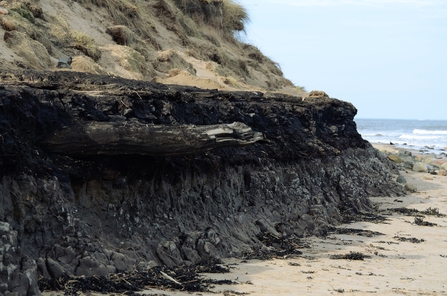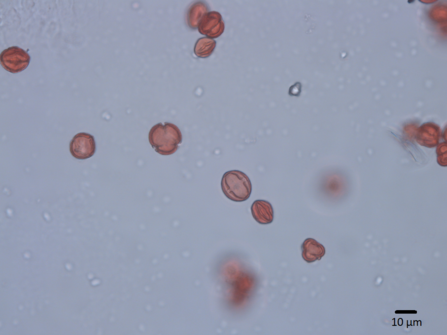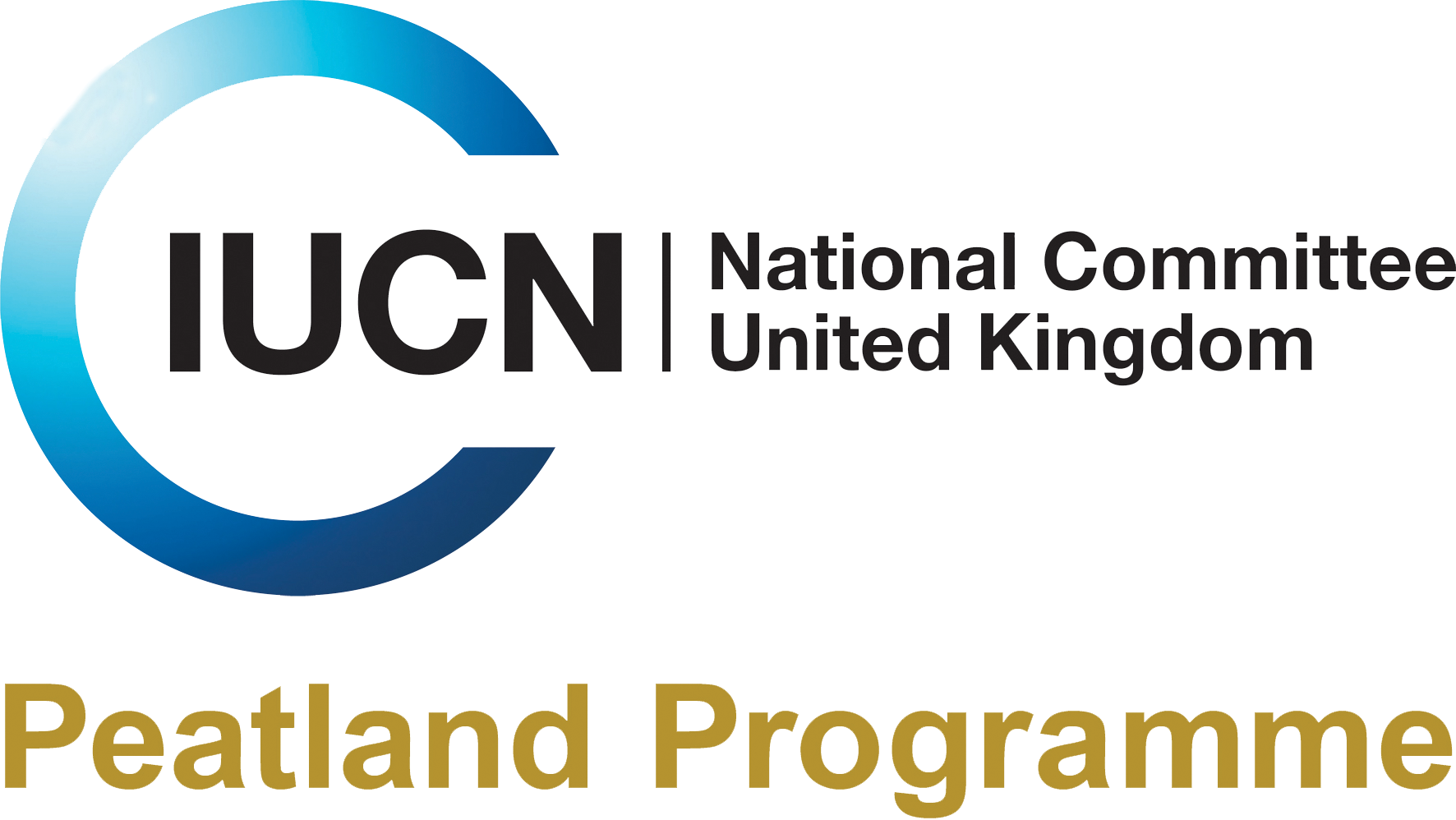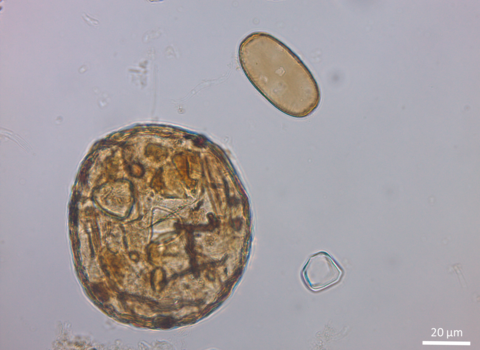Palaeoecology is the study of past ecosystems and their changes through time. Past environments, population dynamics and communities of organisms can be reconstructed based on fossil evidence preserved in the landscape.
The Peat Library- an historic archive
Peatlands are unique historical archives of fossil evidence due to their waterlogged conditions. The lack of oxygen in waterlogged peat slows down decomposition of organic matter, such as plant and animal remains, and organisms can be preserved in peat for thousands of years. Peat accumulates at different rates depending on climatic conditions and the type of peatland habitat, but the accumulation rate in the UK is generally slow – around 1 mm a year on average. The continuous accumulation of layers of peat creates a valuable stratigraphic record of the past. In the UK, peat began accumulating after the last ice age ended around 12,000 years ago, providing a millennial-scale window back in time1.
A peat core taken from Langlands Moss containing remains of wood preserved in peat for 1500 years. Credit Emma Hinchliffe
Some types of fossil evidence preserved in peat (e.g. pollen and woody remains) can reveal information about past environmental conditions, such as temperature or precipitation because certain indicators species are known to be present within certain environmental parameters (e.g. have a particular requirement or tolerance for soil moisture) or a specific temperature range for growth. This evidence of presence of indicator species can then be used in palaeoclimatology – the study and reconstruction of past climates.

Subfossil remains of a tree protruding from eroding coastal peat at Hauxley, Northumberland. Credit Emma Hinchliffe.
Peatlands change over time
As peat is made up of the remains of organisms that lived in and on it, their remains provide direct information about what the peatland itself looked like in the past. Animal macrofossils include bones and teeth of vertebrates and exoskeletons of insects. Remains of some microorganisms, such as the hard shells or ‘tests’ of testate amoebae and the shells of diatoms are also used as proxies (indicators of past environmental conditions) in palaeoecology.
Plant macrofossils are the visible remains of plants, such as fragments of leaves, needles, stems, seeds, wood and bark. Their presence in peat cores helps to reconstruct the past vegetation assemblages on the sampled peatland, as they are usually deposited from the immediate area. A recent example is a 5,000-year old segment of a willow tree complete with associated insects and plant fragments that was recovered from a peatland in Somerset. However, macrofossils tend to be less common in peat than the more abundant microfossils, and the point-sampling nature of extracting a peat core means that the less abundant organisms are less likely to be sampled.
Other remains preserved in peat, such as pollen grains and spores, can be transported by wind or water for tens of kilometres before they are deposited on a peatland. These microfossils can provide valuable insight into the past composition of plants surrounding the peatland and, in some cases, indications of historic land use. For example, hemp pollen has been observed in peat cores from Red Moss of Balerno, just south of Edinburgh, as an artefact of nearby rope production2. It is important to note that some species produce less pollen than others, and it is difficult to differentiate local pollen from regional pollen3. There are limitations to relying on a single method, and it is recommended to use macro- and microfossils in combination, as no single proxy can provide a complete picture of the past3,4.

Pollen grains of dropwort (Filipendula vulgaris) as seen under a light microscope. Credit Helen Harper.
Peat can also preserve information on specific past geological or cultural events. Layers of tephra (ash material produced by volcanic eruptions) can travel large distances and be deposited on peat, indicating past volcanic activity5. Fragments of charcoal buried in peat reveal past wildfire events on or around the peatland. As peat deposits can hold a range of proxies - ecological, cultural, environmental and geological - they are excellent sources for multi-proxy palaeoecological studies.
Methods of analysis in palaeoecology
Peat is usually sampled with a peat corer. The corer is inserted into the peat and rotated to capture a cylindrical sample. Extension rods can be used to reach deeper layers of peat several metres below the surface. They can also extract a continuous column of peat soil from the present surface layers down to deeper historic layers. As indicated above, every 1 m long core of peat extracted from a typical UK peat bog contains evidence from the last c. 1,000 years.
Richard Tripping and Eileen Tindall taking a peat core on Ben Lomond. Credit Alasdair Eckersall
The peat core extracted from Ben Lomond is measured. Credit Alasdair Eckersall
The peat core is then analysed in a laboratory. Sub-samples are taken from different depths along the core. Chemical treatment, heating and sieving of the samples are often used to dissolve humic acids and extract the artefact of interest. Whilst extracting macrofossils and charcoal is relatively straightforward, pollen extraction requires several successive steps and various chemicals to get a clean sample for analysis. Once the excess material is removed, the remaining mixture is spread on a glass slide, ready for observation under a light microscope.
Sub-sampling of a peat core in preparation for analysis. Credit Helen Harper
Macro- and microfossils are counted, recorded and identified where possible, using either a collection of reference specimens or reference guides with descriptions and visuals. Examples of comprehensive online databases to identify pollen and testate amoebae can be a useful resource to guide identification and to understand reference conditions for that species - PalDat and Microworld are comprehensive and accessible online. The identification process requires skill and can be time consuming. For example, when analysing pollen slides, 500 individual grains are conventionally counted and identified at each sampled depth to generate species presence and relative abundance data.
Estimating the age of peat
Aside from the rough estimates provided from the depth of the peat layer from the original bog surface (something that only provides a fair estimate if the bog is in good condition and the original surface is intact), it is also possible to estimate the age of organic material through radiocarbon dating. All fragments of organic material in peat contain the carbon isotope C14. These isotopes are absorbed by plants through photosynthesis and later by organisms that consume plants. After the death of the organism, the C14 isotope begins to decay at a known rate. By measuring the proportion of C14 remaining in an organic sample, it is possible to calculate how long ago the organism died.
Visible tephra layers or microscopic ‘cryptotephras’ in peat are also used to robustly estimate the age of peat sequences. This method relies on linking known and dated volcanic eruptions with tephra found in peat, based on the composition of tephra5. Annual tree rings of preserved subfossil trees can further provide a high-resolution record of past climatic and atmospheric conditions that prevailed during the lifetime of the tree4.
Application of palaeoecology to peatland restoration
Palaeoecological data can be used to guide present day peatland restoration. Knowledge of past structure, function and biological composition of a peatland prior to human impact can be used to establish baseline ecological conditions and to set targets for peatland restoration6. In the UK, this has been applied in North West England and Ireland7.
Knowing what past peatlands were composed of ensures that the criteria we impose on peatlands reflects the ecological truth rather than our interpretation of what these landscapes should look like. However, this is not to say that the aim should be to re-create a past landscape. Instead, the past records can provide valuable information about natural processes that have created the peatland, and this knowledge can be used to inform how the peatland is managed in the future.
Palaeoecology can also provide a window to the future. Past records demonstrate natural variability in environmental conditions over time and reveal how peatlands responded to past disturbances8. Palaeoecological records have demonstrated that peatlands have been resilient to past disturbances (e.g. fires, droughts, climatic warming periods) and have gradually regenerated original plant communities and restored their ecological functions. It is important that land managers understand past changes to be able to predict potential future responses of the landscape to physical drivers6. The predicted changes in climate make it particularly important that land managers look beyond short-term time scales, and see peatlands as dynamic landscapes, incorporating an anticipation of change into decision-making6.
However, palaeoecological studies require time, expertise and resources, which limit their accessibility for wider use among practitioners. Palaeoecological methods currently remain underutilised in peatland restoration work8.
Translational palaeoecology
Translational palaeoecology is a relatively new concept that refers to an increased dialogue between scientists and practitioners to encourage the use of palaeoecological data to inform current peatland management and conservation. There is a need to design research with this goal in mind, creating partnerships between scientists, practitioners, policy makers and relevant stakeholders to ensure research is able to inform restoration practice. To ensure that management questions are being addressed and that relevant practitioners are being informed, these partnerships should seek to engage in collaborative discussions from the start of the research process6.
By developing the practice of translational palaeoecology, researchers can work with the wider peatland community to apply their specialist knowledge and expertise, informing the future of peatlands, as well as understanding their past. We explored the topic at our 2024 annual conference and a recent paper from The University of Manchester provides a five-phase framework that can be used to guide research-practice collaboration, from designing research questions through to post-research engagement9.
#PeatConf24: Translational Palaeoecology and the Art of Collaboration workshop
References
- Historic England. Peatlands and the Historic Environment: An Introduction to their Cultural and Heritage Value. Historic England. 2021.
- Warman J. Scottish Wildlife Trust. Personal communication.
- Birks HH and Birks HJB. Future Uses of Pollen Analysis Must Include Plant Macrofossils. Journal of Biogeography, 2000;27(1): 31–35. http://www.jstor.org/stable/2655981
- Edvardsson J, Helama S, Rundgren M, Nielsen AB. The Integrated Use of Dendrochronological Data and Paleoecological Records From Northwest European Peatlands and Lakes for Understanding Long-Term Ecological and Climatic Changes—A Review. Frontiers in Ecology and Evolution. 2022;10:781882. https://doi.org/10.3389/fevo.2022.781882.
- Watson EJ, Swindles GT, Lawson IT, Savov IP. Spatial variability of tephra and carbon accumulation in a Holocene peatland. Quaternary Science Reviews. 2015;124: 248-264. https://doi.org/10.1016/j.quascirev.2015.07.025.
- Wingard GL, Bernhardt CE, Wachnicka AH. The Role of Paleoecology in Restoration and Resource Management—The Past as a Guide to Future Decision-Making: Review and Example from the Greater Everglades Ecosystem, U.S.A. Frontiers in Ecology and Evolution. 2017;5(11). https://doi.org/10.3389/fevo.2017.00011.
- Valentine J, Davis SR, Kirby JR, Wilkinson DM. The Use of Testate Amoebae in Monitoring Peatland Restoration Management: Case Studies from North West England and Ireland. Acta Protozoologica. 2013;52: 129–145. doi:10.4467/16890027AP.13.0013.1110
- Bonnett SAF, Ross S, Linstead C, Maltby E. A review of techniques for monitoring the success of peatland restoration. 2009. University of Liverpool. Natural England Commissioned Reports, Number 086.
- Gauld J, Fletcher WJ, Shuttleworth EL, Akerman J, Angus M, Barrowclough C, Bennion H, Blundell A, Bromwich D, Davies AL, Dietl GP, Ezquerra FJ, Farrell M, Flessa K, Froyd C, Fyfe R, Gillard M, Gledhill R, Harper H, … Wright P. Towards a process of translational palaeoecology: A practical guide to research co-production. Ecological Solutions and Evidence. 2025; 6, e70111. https://doi.org/10.1002/2688-8319.70111

